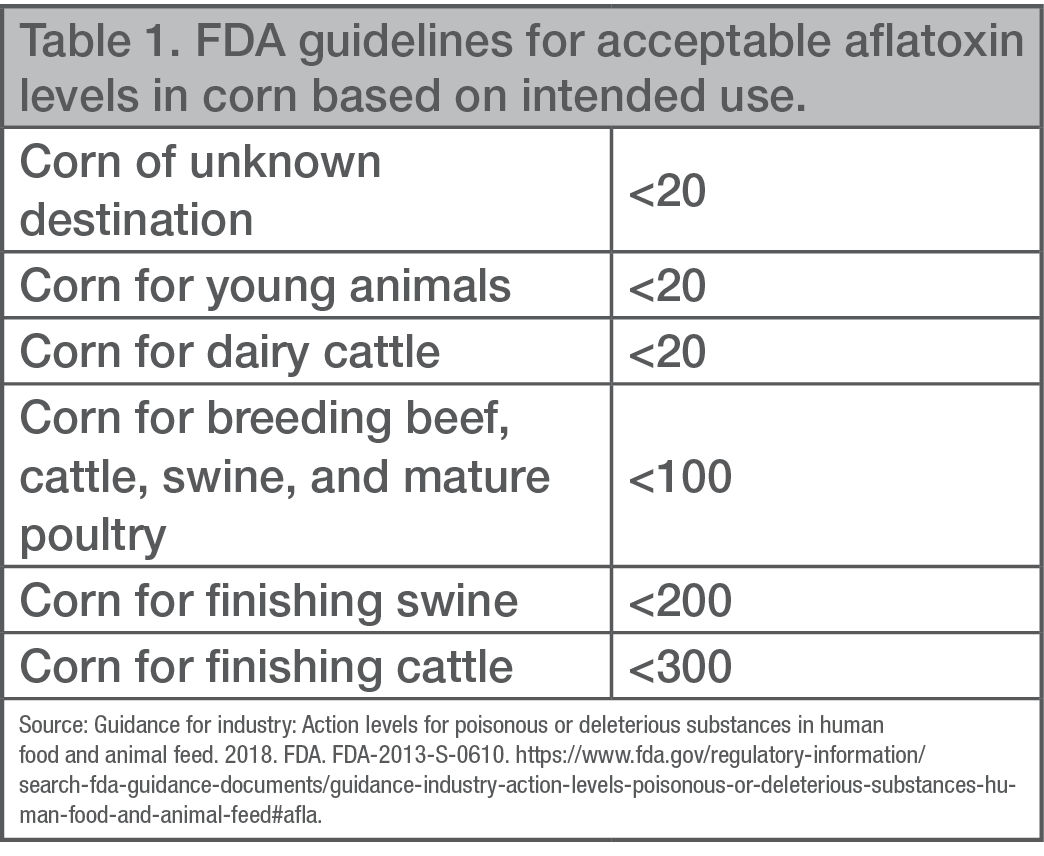Identifying Aspergillus Ear Rot in Corn and Management Strategies
October 1, 2024
Aspergillus ear rot, primarily caused by the Aspergillus flavus fungi, is a large concern in corn production due to its impact on potential crop yield and the potential for contamination of corn grain with aflatoxins, which are harmful to human and animal health. Identifying Aspergillus ear rot in corn early is crucial for managing its spread and minimizing its detrimental effects. Infection is most likely to occur during hot, dry weather after pollination if Aspergillus spores are present.
Identification of Aspergillus Rot
Aspergillus ear rot can be found as a powdery, yellow-green or olive mold on corn kernels and cob (Figure 1). The mold is usually more prominent on ear tips but can spread across the entire ear. Stressed or damaged ears from insects, birds, or hail may be more susceptible to infection. The infection often begins in the field but can continue to develop when ensiled, particularly under warm and humid conditions.

Aspergillus ear rot can produce a musty or earthy odor, which becomes more noticeable as the infection progresses. This odor can be a useful diagnostic tool, especially when visual symptoms are not yet pronounced. While not visible, the presence of aflatoxins, toxic metabolites potentially produced by Aspergillus, may be present and can result in an inability to market infected grain. Laboratory analysis is used to detect the presence of aflatoxins. The United States Food and Drug Association (FDA) has established guidelines for aflatoxin infected grain use (Table 1).

Pre-Harvest Management
- Crop Rotation and Field Sanitation: Rotating corn with non-host crops can help reduce the buildup of Aspergillus spores in the soil. Additionally, removing previous crop residue helps decrease the fungal inoculum.
- Corn Products: Selecting corn products with tighter husks, favorable characteristics for enduring drought and heat stress, and insect trait protection can help reduce the potential for infection.
- Optimal Planting Time: Planting corn early in the season can help avoid the warm and dry conditions that favor Aspergillus growth during the critical grain-filling period. When available, irrigation during drought periods also reduces crop stress, making corn potentially less vulnerable to infection.
- Pest Control: Insect pests, particularly those that damage corn ears, can create entry points for Aspergillus fungi. Controlling pests through integrated pest management (IPM) practices and trait protected corn products can help manage and reduce the potential for infection.
Post-Harvest Management
- Proper Drying and Storage: Corn should be dried to a moisture content of 13 to 15% soon after harvest to help inhibit fungal growth. Storage conditions should be cool and dry, with good aeration to help prevent moisture buildup that could encourage Aspergillus mold growth.
- Regular Monitoring: Stored corn should be regularly checked for signs of mold growth and aflatoxin contamination. Using moisture testers and periodic testing for aflatoxins can help identify problems before they become widespread.
- Proper Disposal: Infected corn that is not suitable for consumption should be properly disposed of to prevent the spread of spores. Composting or burning the infected material can help reduce the fungal load in the environment.
Conclusion
Identifying Aspergillus ear rot in corn early and implementing IPM strategies are vital steps in safeguarding corn production. By combining good agricultural practices, careful monitoring, and innovative technologies, the spread of Aspergillus ear rot can likely be minimized which can help ensure crop quality and safety.
Channel Agronomist
Christian McGuire
Sources
Woloshuk, C. and Wise, K. 2011. Aspergillus ear rot. Diseases of Corn. BP-83-W. Purdue Extension. Purdue University. https://www.extension.purdue.edu/extmedia/bp/bp-83-w.pdf
Guidance for industry: Action levels for poisonous or deleterious substances in human food and animal feed. Guidance Document. 2000. U.S. Food & Drug Administration. FDA. https://www.fda.gov/regulatory-information/search-fda-guidance-documents/guidance-industry-action-levels-poisonous-or-deleterious-substances-human-food-and-animal-feed#afla
Wise, K. 2013. Managing rotten corn: An overview of corn ear rots. Plant Diseases. Pest & Crop. Purdue Cooperative Extension Service. Purdue University. https://extension.entm.purdue.edu/pestcrop/index.html
Web sources verified 8/27/24 1110_442933